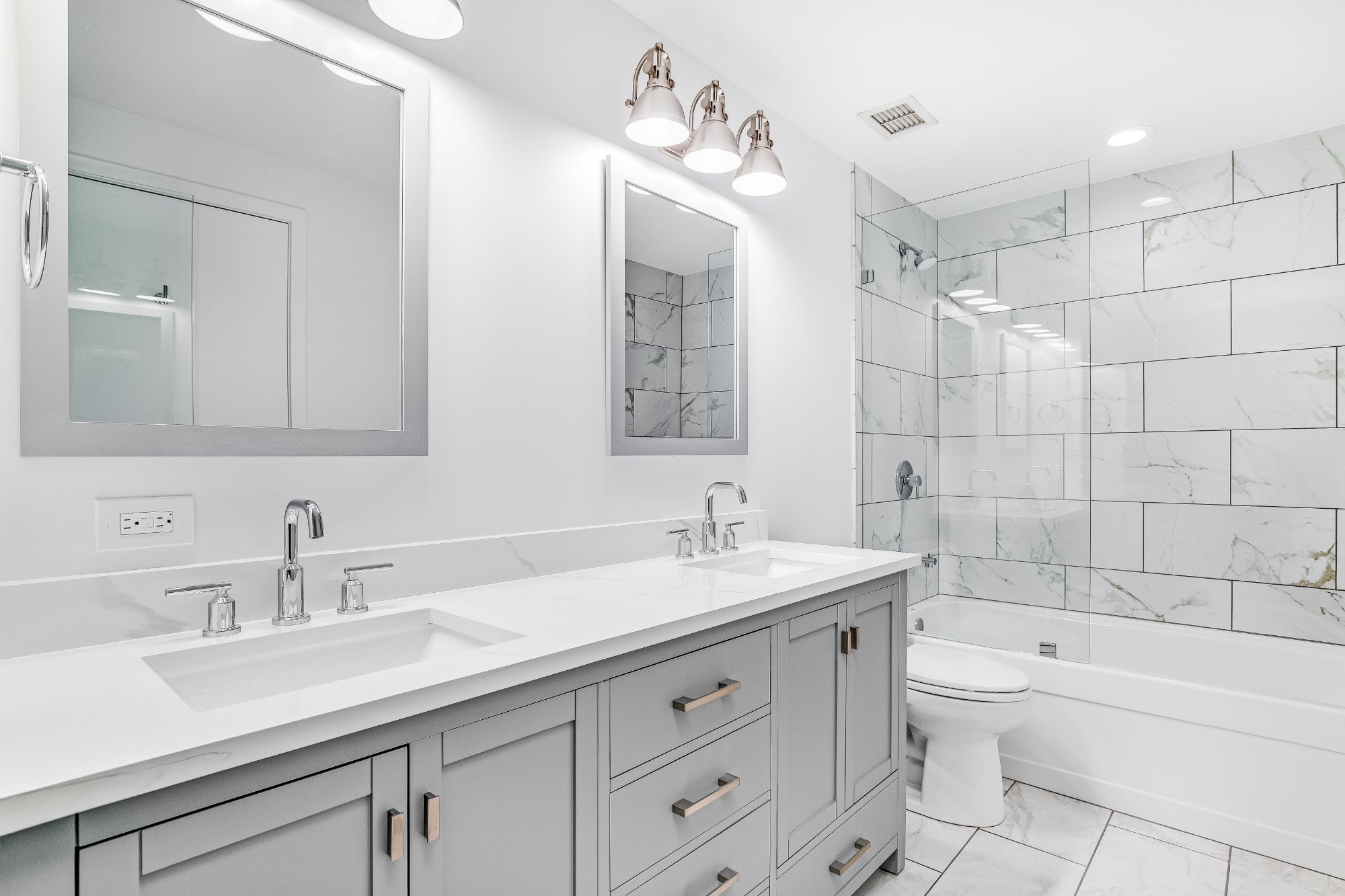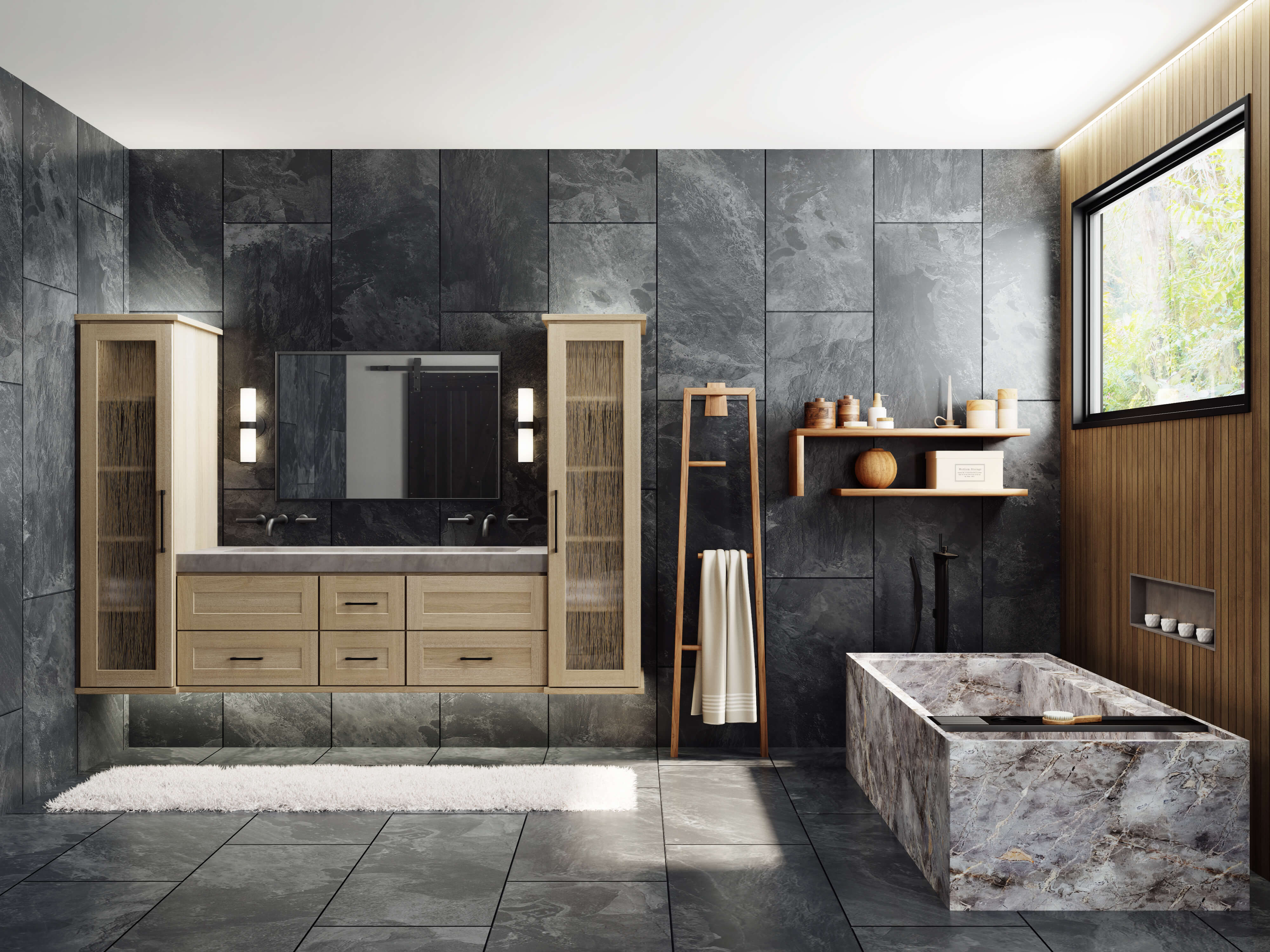Beyond the Traditional
The conventional bathroom vanity, with its standard cabinets and countertop, has long served as a staple in bathroom design. However, the rise of contemporary aesthetics and a desire for personalized spaces has led to a shift towards more unique and expressive vanity designs. This departure from tradition opens up a world of possibilities, allowing homeowners to create bathroom sanctuaries that reflect their individual style and needs.
Floating Vanities: Embracing Minimalism
Floating vanities, characterized by their sleek and minimalist design, offer a contemporary and space-saving solution for modern bathrooms. These vanities appear to float effortlessly above the floor, creating an illusion of spaciousness and airiness. The absence of bulky legs and traditional cabinets contributes to a sense of lightness and openness, making the bathroom feel larger and more inviting.
Floating vanities often feature a simple, streamlined countertop with integrated sinks, further enhancing their minimalist appeal. The lack of visible storage can be a drawback for some, requiring creative solutions for organizing toiletries and other bathroom essentials. However, the minimalist aesthetic can be balanced by incorporating wall-mounted shelves or open storage solutions, allowing for a visually appealing and functional arrangement.
Materials
Stepping away from the conventional in bathroom vanity design often involves exploring unconventional materials. This approach allows you to personalize your space and create a unique aesthetic that reflects your style.
Popular Vanity Materials
Popular vanity materials like wood, stone, and metal offer a wide range of options for creating a beautiful and functional bathroom space. However, exploring alternative materials can help you break away from the ordinary and create a truly unique bathroom.
- Wood: A timeless and versatile material, wood offers a warm and natural feel. It comes in various species, each with unique grain patterns and color variations. From durable hardwoods like oak and maple to softer woods like pine and cherry, wood can be stained or painted to match any design aesthetic. However, wood requires regular maintenance, including sealing and refinishing, to prevent damage from moisture and wear. It can also be susceptible to scratches and water damage, especially in high-humidity environments.
- Stone: Stone vanities exude elegance and sophistication. Materials like granite, marble, and quartz are known for their durability, resistance to scratches and stains, and natural beauty. Stone vanities are also highly customizable, allowing for a variety of finishes and edges. However, stone is a heavy material that requires professional installation. It can also be susceptible to etching from acidic substances like lemon juice and vinegar.
- Metal: Metal vanities offer a modern and industrial aesthetic. Stainless steel, copper, and bronze are popular choices for their durability, resistance to rust, and sleek appearance. Metal vanities can be customized with different finishes, such as brushed, polished, or powder-coated. However, metal vanities can be prone to fingerprints and scratches, requiring regular cleaning and maintenance.
Alternative Vanity Materials, Alternative bathroom vanity ideas
While traditional materials offer a solid foundation for bathroom vanities, exploring alternative materials can create a truly unique and personalized space.
Concrete
Concrete is a durable and versatile material that can be molded into various shapes and sizes. Concrete vanities offer a modern and industrial aesthetic, adding a touch of raw elegance to any bathroom. Concrete is also relatively inexpensive and can be customized with different colors, finishes, and textures. However, concrete is a porous material that requires sealing to prevent staining and water damage. It can also be heavy and requires professional installation.
Recycled Materials
Sustainability is becoming increasingly important in bathroom design. Using recycled materials like reclaimed wood, salvaged metal, or repurposed glass can create a unique and eco-friendly vanity. These materials offer a distinctive character and history, adding a unique touch to your bathroom. However, recycled materials may require additional preparation and finishing to ensure durability and functionality.
Glass
Glass vanities offer a sleek and transparent design, creating an illusion of space and adding a touch of modern sophistication. Glass vanities can be customized with different colors, textures, and finishes, allowing for a unique and personalized look. However, glass is a fragile material that requires careful handling and maintenance. It can also be susceptible to scratches and fingerprints.
Functionality: Alternative Bathroom Vanity Ideas

A bathroom vanity’s functionality goes beyond just aesthetics. It’s about creating a space that’s both practical and stylish, ensuring everything has its place and is easily accessible. This means considering various storage solutions, from traditional cabinets to more creative options.
Open Shelving
Open shelving offers a visually appealing and accessible storage solution. They create a sense of openness and allow for easy access to frequently used items. This is especially beneficial for displaying decorative items, towels, or toiletries.
Open shelves are ideal for displaying decorative items or frequently used toiletries.
- Benefits:
- Easy access to items.
- Creates a visually appealing and open space.
- Ideal for displaying decorative items.
- Drawbacks:
- Can make the bathroom look cluttered if not organized properly.
- Not ideal for storing sensitive items, as they are exposed.
- May collect dust and require regular cleaning.
Built-in Drawers
Built-in drawers offer a more discreet and organized storage solution. They provide a hidden space for toiletries, towels, and other bathroom essentials. By incorporating organizers and dividers, you can maximize space and keep everything in its place.
Built-in drawers offer a discreet and organized storage solution.
- Benefits:
- Provides ample storage space.
- Keeps items organized and out of sight.
- Offers a more streamlined and polished look.
- Drawbacks:
- Can be more expensive than open shelving.
- Requires careful planning and measurement to ensure a good fit.
- May require specialized tools for installation.
Hidden Compartments
Hidden compartments offer a discreet storage solution for items you don’t want on display. These can be integrated into the vanity itself, behind a mirror, or within the walls. This provides a secure and organized space for sensitive items like medication, jewelry, or personal documents.
Hidden compartments offer a discreet storage solution for sensitive items.
- Benefits:
- Provides a secure and discreet storage space.
- Keeps sensitive items out of sight.
- Adds an element of surprise and intrigue to the bathroom design.
- Drawbacks:
- Can be more challenging to install and may require professional assistance.
- May require careful planning and measurement to ensure a good fit.
- May be more expensive than other storage options.
Lighting

Lighting plays a crucial role in shaping the ambiance of your bathroom, influencing both its functionality and aesthetic appeal. Beyond just providing illumination, strategically placed lighting can enhance the space, accentuate its features, and create a mood that complements your personal style.
Under-Cabinet Lighting
Under-cabinet lighting is an excellent choice for task-oriented illumination, providing focused light on the vanity countertop. This type of lighting is particularly beneficial for applying makeup, shaving, or performing other tasks that require clear visibility. It can also be used to highlight the vanity’s design features, creating a sense of depth and dimension.
Pendant Lights
Pendant lights offer a stylish and decorative touch to the bathroom vanity, adding a focal point and enhancing the overall aesthetic. They can be positioned above the vanity mirror, casting a soft, ambient light that complements the space. Pendant lights come in a variety of styles and materials, allowing you to choose an option that aligns with your bathroom’s design theme.
Wall Sconces
Wall sconces provide ambient lighting, casting a warm and inviting glow that creates a relaxing atmosphere. They can be placed on either side of the vanity mirror, providing balanced illumination and a sophisticated feel. Wall sconces are available in various designs and finishes, allowing you to find the perfect match for your bathroom’s decor.
Beyond the Vanity

Your bathroom vanity is more than just a storage solution; it’s a design element that can significantly impact the overall aesthetic of your bathroom. Choosing the right vanity style can create a cohesive and harmonious look, transforming your bathroom into a haven of style and functionality.
Integrating Vanity Styles with Bathroom Design
The key to a successful bathroom design lies in creating a unified and cohesive look. Your vanity should seamlessly blend with the other elements of your bathroom, such as the shower enclosure, bathtub, flooring, wall tiles, and accessories. This integration ensures that the design flows smoothly and creates a visually appealing space.
Shower Enclosures and Bathtub Designs
- Matching Materials: If your shower enclosure features glass, consider a vanity with glass elements, like a glass countertop or cabinet doors. Similarly, if your shower has a stone or tile surround, a vanity with a matching stone or tile countertop can create a cohesive look.
- Complementary Styles: A modern vanity with sleek lines and minimalist design would complement a contemporary shower enclosure with frameless glass doors. Conversely, a traditional vanity with ornate details and a curved design would pair well with a classic clawfoot bathtub.
- Color Harmony: Choose a vanity color that complements the colors of your shower enclosure or bathtub. For example, a white vanity would create a clean and bright look with a white shower enclosure, while a dark wood vanity would provide a sophisticated contrast.
Flooring and Wall Tile Selections
- Material Continuity: If your bathroom features a tile floor, consider extending the tile to the vanity backsplash or even the countertop. This creates a seamless transition and adds a sense of unity to the space.
- Complementary Patterns: Choose a vanity that complements the patterns of your floor and wall tiles. For example, a vanity with a simple design would work well with patterned tiles, while a vanity with intricate details would complement a more minimalist tile design.
- Color Coordination: The color of your vanity should complement the colors of your flooring and wall tiles. A light-colored vanity can brighten a space with dark flooring, while a dark vanity can add a touch of sophistication to a light-colored space.
Bathroom Accessories and Fixtures
- Style Consistency: Ensure that the style of your vanity matches the style of your bathroom accessories and fixtures. For example, a modern vanity would pair well with chrome faucets and sleek towel bars, while a traditional vanity would complement brushed nickel fixtures and ornate towel rings.
- Material Harmony: Consider using the same materials for your vanity and other bathroom accessories. For example, a vanity with a stone countertop could be complemented by stone soap dishes and toothbrush holders.
- Color Palette: Maintain a consistent color palette throughout your bathroom. If your vanity features a specific color, try to incorporate that color into other accessories, such as towels, rugs, and shower curtains.
